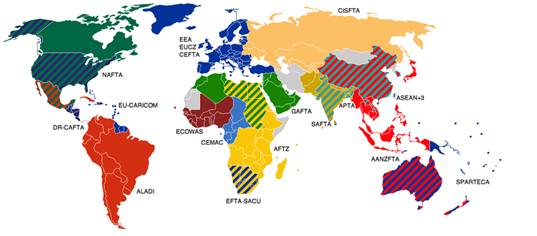Regional economic groups / blocs
 The purpose of creating trading blocs is to reduce or eliminate unnecessary trade barriers between member states, and to allow the free movement of goods, services, labour and capital.
The purpose of creating trading blocs is to reduce or eliminate unnecessary trade barriers between member states, and to allow the free movement of goods, services, labour and capital.
However, non-members of trading blocs are facing with financial and non-financial restrictions on their exports to these blocs, such as tariffs, quotas and even embargoes. As a result it is difficult for any country to survive outside one of these blocs and the world is splitting into expanding groups of trading nations promoting free trade between themselves, at the same time as they are restricting it to those countries outside of their blocs.
Pros and Cons of Regional Integration
There are many theoretical advantages and disadvantages that come with regional integration,
The advantages include:
- Less chance of conflict and war.
- Larger markets and customer base allows businesses within member countries to exploits economies of scale.
- Freedom of movement of goods and peoples.
- Increased global significance.
- Improving environmental and social conditions.
- The promotion of democracy and liberalisation.
- Trade creation-the elimination of protectionism increases trade, leading to a more efficient allocation of member state resources.
The disadvantages include:
- Loss of sovereignty, independence, and national identity.
- Loss of national power in favour of even bigger government.
- Increased competition leading to job losses in some domestic industries.
- Loss of border control and the increased risk of smuggled goods and people.
- Uniform laws don't account for cultural differences.
- Trade diversion - the elimination of trade barriers among the member states may divert trade away from more efficient non-member states that are disadvantaged by the protectionism they still face.
Protectionism
Protectionism arises because countries may not always feel that they benefit from completely free trade. While they may understand that free trade will benefit everyone, they may be suffering some of the costs associated with trade and feel that they want to restrict aspects of trading activity. These restrictions are known as protectionism. Trading blocs practice varieties of protectionist behaviour.
Examples of protectionist policies include:
- Tariffs - a tariff is a tax on imports. Tariffs reduce supply and raise the price of imports. This gives domestic equivalents a competitive advantage. Tariffs will often be charged by regional trading blocs on imports from countries outside the area. The EU charges a common external tariff (CET) to many goods imported into the EU.
- Quotas - quotas have the effect of restricting the maximum amount of imports allowed into an economy. Once again they reduce the amount of imports entering an economy and increase the equilibrium price within the market. The government receives no revenue from a quota, as it does with a tariff, unless it can set up a system of licences.
- Export subsidies - export subsidies allow exporters to supply the market with more product than the natural market equilibrium would have allowed. Foreign consumers will enjoy increased economic welfare as the price of their purchases fall. Domestic employees might enjoy more wages and job security, but domestic taxpayers are footing the bill for this.
- Embargo - imports from certain countries are completely prohibited.
- Administrative barriers - countries or regional blocs can also use a range of administrative or legal devices to slowdown imports and to add costs. These can include the importing firm being required to obtain various licences and permits.
